CITROEN NEMO DAG 2013 Handbook (in English)
Manufacturer: CITROEN, Model Year: 2013, Model line: NEMO DAG, Model: CITROEN NEMO DAG 2013Pages: 180, PDF Size: 9.06 MB
Page 131 of 180
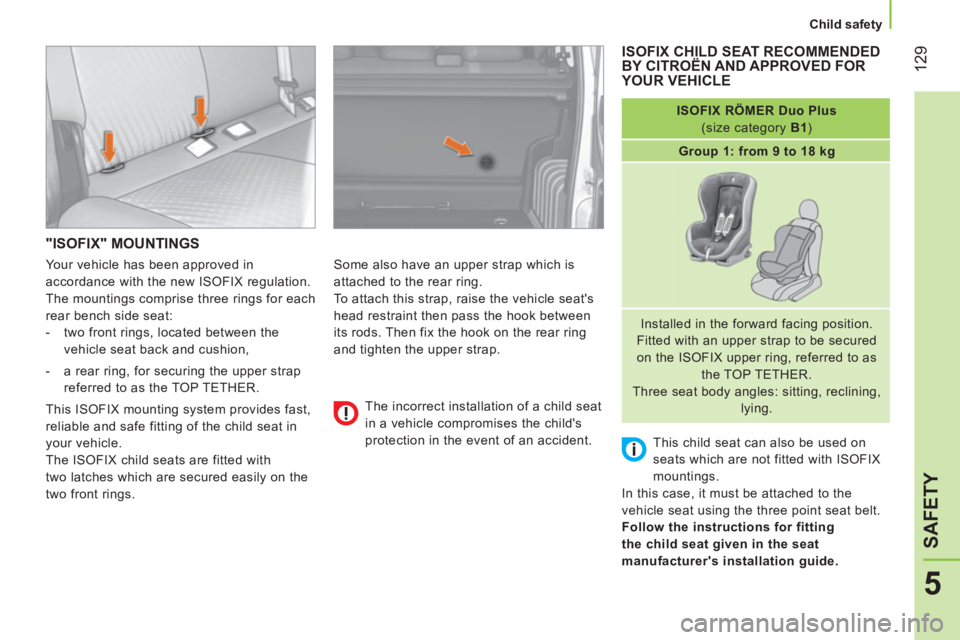
129
5
SAFETY
Child safety
"ISOFIX" MOUNTINGS
Some also have an upper strap which is
attached to the rear ring.
To attach this strap, raise the vehicle seat's
head restraint then pass the hook between
its rods. Then fix the hook on the rear ring
and tighten the upper strap.
ISOFIX
RÖMER Duo Plus
(size category B1
)
Group 1: from 9 to 18 kg
Installed in the forward facing position.
Fitted with an upper strap to be secured
on the ISOFIX upper ring, referred to as
the TOP TETHER.
Three seat body angles: sitting, reclining,
lying.
This child seat can also be used on
seats which are not fitted with ISOFIX
mountings.
In this case, it must be attached to the
vehicle seat using the three point seat belt.
Follow the instructions for fitting
the child seat given in the seat
manufacturer's installation guide.
The incorrect installation of a child seat
in a vehicle compromises the child's
protection in the event of an accident.
ISOFIX CHILD SEAT RECOMMENDED
BY CITROËN AND APPROVED FOR
YOUR VEHICLE
Your vehicle has been approved in
accordance with the new ISOFIX regulation.
The mountings comprise three rings for each
rear bench side seat:
- two front rings, located between the
vehicle seat back and cushion,
- a rear ring, for securing the upper strap
referred to as the TOP TETHER.
This ISOFIX mounting system provides fast,
reliable and safe fitting of the child seat in
your vehicle.
The ISOFIX child seats are fitted with
two latches which are secured easily on the
two front rings.
Page 132 of 180
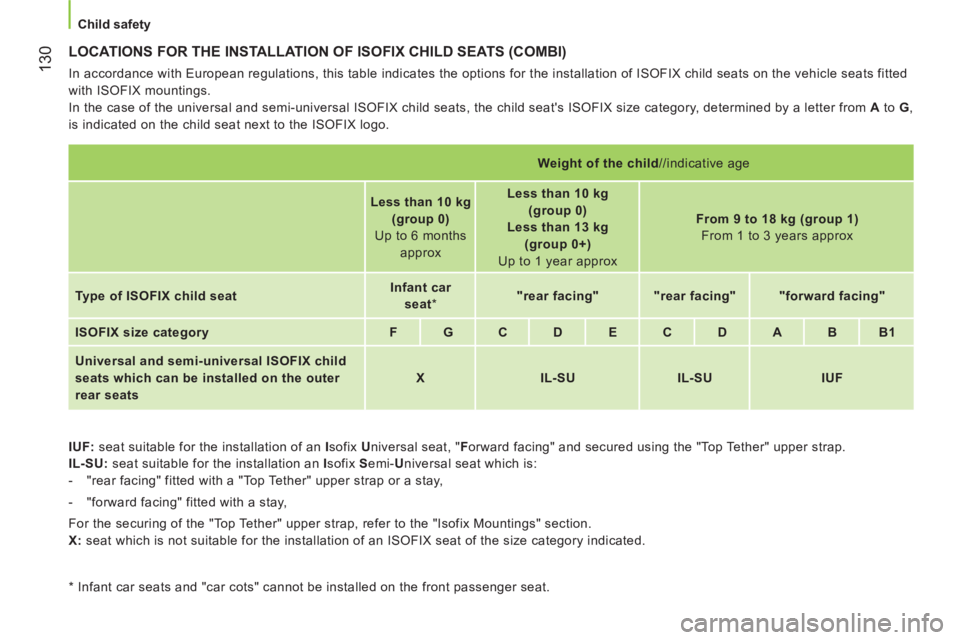
130
Child safety
LOCATIONS FOR THE INSTALLATION OF ISOFIX CHILD SEATS (COMBI)
In accordance with European regulations, this table indicates the options for the installation of ISOFIX child seats on the vehicle seats fitted
with ISOFIX mountings.
In the case of the universal and semi-universal ISOFIX child seats, the child seat's ISOFIX size category, determined by a letter from A
to G
,
is indicated on the child seat next to the ISOFIX logo.
IUF:
seat suitable for the installation of an I
sofix U
niversal seat, " F
orward facing" and secured using the "Top Tether" upper strap.
IL-SU:
seat suitable for the installation an I
sofix S
emi- U
niversal seat which is:
- "rear facing" fitted with a "Top Tether" upper strap or a stay,
- "forward facing" fitted with a stay,
For the securing of the "Top Tether" upper strap, refer to the "Isofix Mountings" section.
X:
seat which is not suitable for the installation of an ISOFIX seat of the size category indicated.
Weight of the child/ /indicative age
Less than 10 kg
(group 0)
Up to 6 months
approx
Less than 10 kg
(group 0)
Less than 13 kg
(group 0+)
Up to 1 year approx
From 9 to 18 kg (group 1)
From 1 to 3 years approx
Type of ISOFIX child seat
Infant car
seat
*
"rear facing"
"rear facing"
"forward facing"
ISOFIX size category
F
G
C
D
E
C
D
A
B
B1
Universal and semi-universal ISOFIX child
seats which can be installed on the outer
rear seats
X
IL-SU
IL-SU
IUF
*
Infant car seats and "car cots" cannot be installed on the front passenger seat.
Page 133 of 180
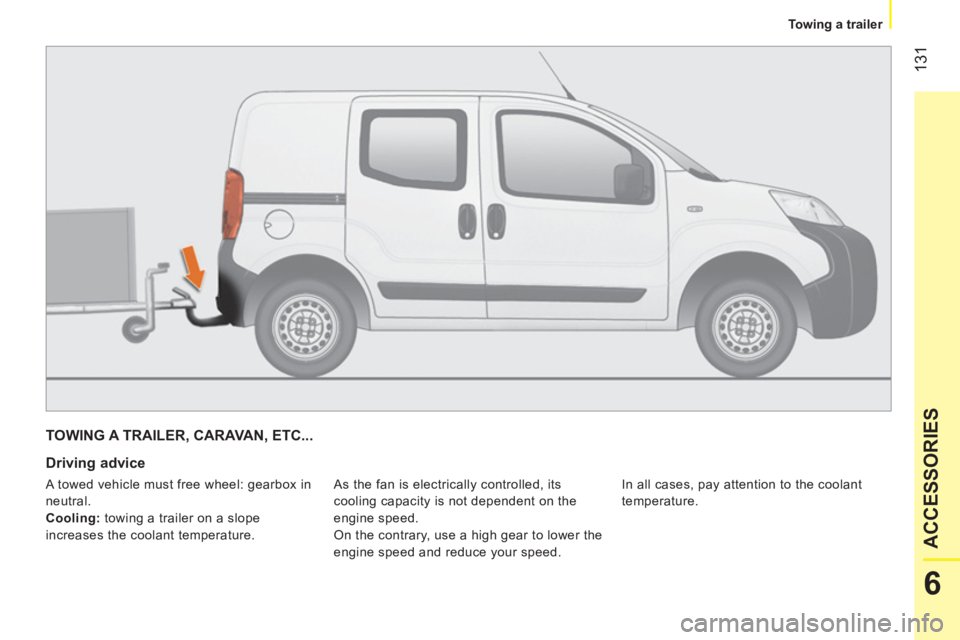
131
6
ACCESSORIES
Towing a trailer
TOWING A TRAILER, CARAVAN, ETC...
Driving advice
As the fan is electrically controlled, its
cooling capacity is not dependent on the
engine speed.
On the contrary, use a high gear to lower the
engine speed and reduce your speed. In all cases, pay attention to the coolant
temperature. A towed vehicle must free wheel: gearbox in
neutral.
Cooling:
towing a trailer on a slope
increases the coolant temperature.
Page 134 of 180
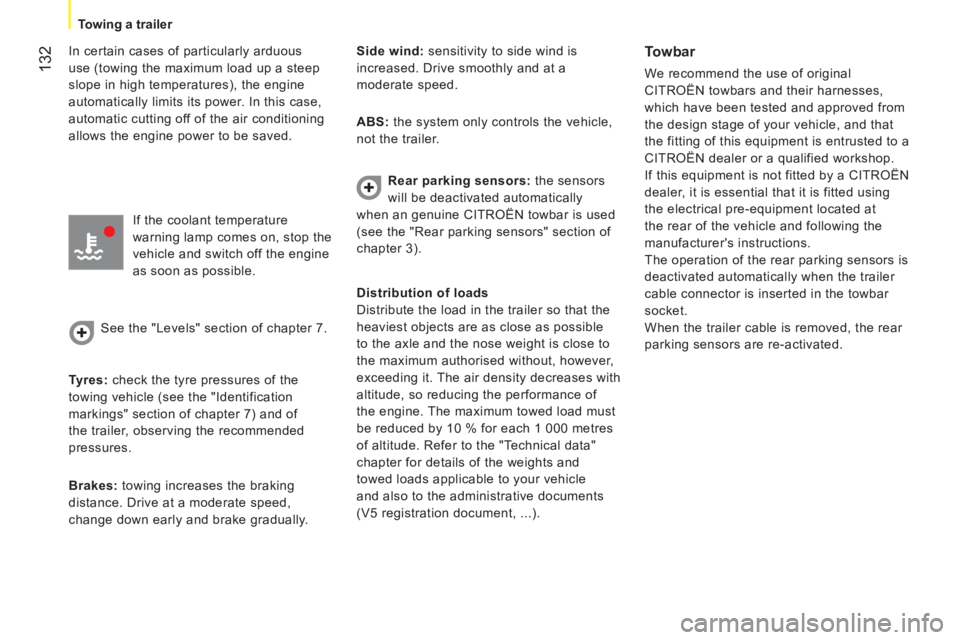
132
Towing a trailer
In certain cases of particularly arduous
use (towing the maximum load up a steep
slope in high temperatures), the engine
automatically limits its power. In this case,
automatic cutting off of the air conditioning
allows the engine power to be saved.
If the coolant temperature
warning lamp comes on, stop the
vehicle and switch off the engine
as soon as possible.
See the "Levels" section of chapter 7.
Tyres:
check the tyre pressures of the
towing vehicle (see the "Identification
markings" section of chapter 7) and of
the trailer, observing the recommended
pressures.
Brakes:
towing increases the braking
distance. Drive at a moderate speed,
change down early and brake gradually.
Side wind:
sensitivity to side wind is
increased. Drive smoothly and at a
moderate speed.
ABS:
the system only controls the vehicle,
not the trailer.
Rear parking sensors:
the sensors
will be deactivated automatically
when an genuine CITROËN towbar is used
(see the "Rear parking sensors" section of
chapter 3).
Towbar
We recommend the use of original
CITROËN towbars and their harnesses,
which have been tested and approved from
the design stage of your vehicle, and that
the fitting of this equipment is entrusted to a
CITROËN dealer or a qualified workshop.
If this equipment is not fitted by a CITROËN
dealer, it is essential that it is fitted using
the electrical pre-equipment located at
the rear of the vehicle and following the
manufacturer's instructions.
The operation of the rear parking sensors is
deactivated automatically when the trailer
cable connector is inserted in the towbar
socket.
When the trailer cable is removed, the rear
parking sensors are re-activated.
Distribution of loads
Distribute the load in the trailer so that the
heaviest objects are as close as possible
to the axle and the nose weight is close to
the maximum authorised without, however,
exceeding it. The air density decreases with
altitude, so reducing the performance of
the engine. The maximum towed load must
be reduced by 10 % for each 1 000 metres
of altitude. Refer to the "Technical data"
chapter for details of the weights and
towed loads applicable to your vehicle
and also to the administrative documents
(V5 registration document, ...).
Page 135 of 180

133
6
ACCESSORIES
Equipment
ROOF RACK AND ROOF BARS
To install the transverse roof bars or a
roof rack, use the fixings provided for this
purpose.
Maximum load: 75 kg.
OTHER ACCESSORIES
A wide range of accessories and original
parts is offered by the CITROËN network.
These accessories and parts have been
tested and approved both for reliability and
for safety.
They all benefit from CITROËN's
recommendation and warranty.
Never exceed the gross vehicle weight
(GVW).
Range of professional equipment
The replacement parts department publishes
an accessories catalogue offering various
equipment and fittings, such as:
- wooden protective floor, non-slip wooden
floors, wooden side protectors, glass
protection grilles,
- roof rack, set of transverse roof bars,
loading roller,
- towbars, towbar harnesses with
7/13 sockets, 7/7 sockets, 13 socket...
The fitting of electrical equipment or
accessories not listed by CITROËN
may result in the failure of your vehicle's
electronic system or high consumption.
Please note this specific warning. You
are advised to contact a representative
of CITROËN to be shown the range of
recommended equipment and accessories.
Depending on the country in which the
vehicle is sold or operated, it may be
compulsory to have a high visibility vest,
warning triangle, replacement bulbs and
fuses available in the vehicle.
Before installing accessory radio
communication transmitters with
external aerial on your vehicle, you can
contact a CITROËN dealer, who will provide
the specification (frequency band, maximum
output power, aerial position, specific
installation conditions) of the transmitters
which can be fitted, in accordance with the
Motor Vehicle Electromagnetic Compatibility
Directive (2004/104/EC). When fitting a towbar and harness
outside the CITROËN dealer
network, the installation must be done
using the electrical pre-equipment on the
vehicle and following the manufacture's
recommendations.
Page 136 of 180
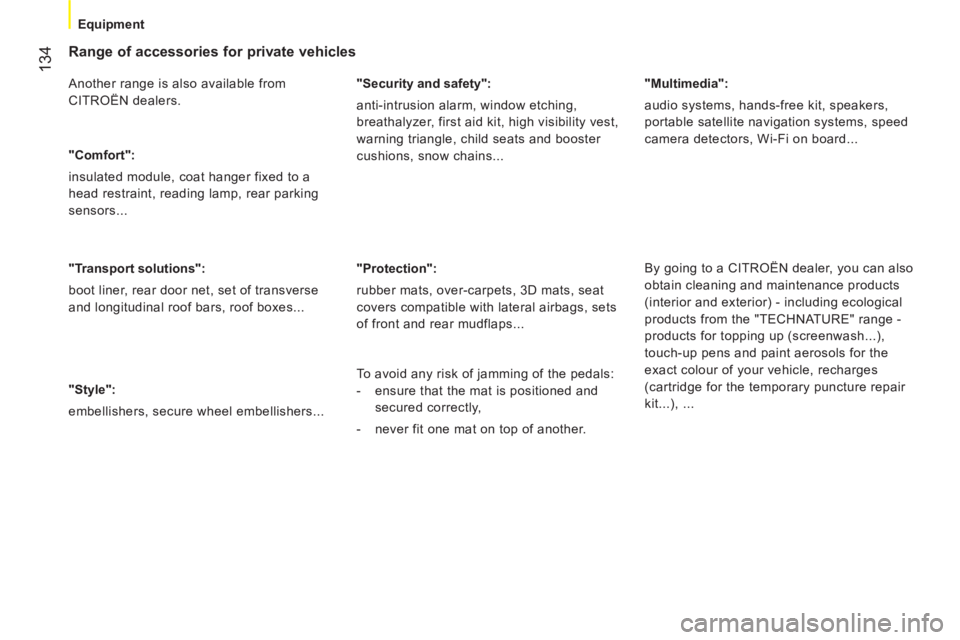
134
Equipment
Range of accessories for private vehicles
Another range is also available from
CITROËN dealers.
"Comfort":
insulated module, coat hanger fixed to a
head restraint, reading lamp, rear parking
sensors...
"Transport solutions":
boot liner, rear door net, set of transverse
and longitudinal roof bars, roof boxes...
"Style":
embellishers, secure wheel embellishers...
"Security and safety":
anti-intrusion alarm, window etching,
breathalyzer, first aid kit, high visibility vest,
warning triangle, child seats and booster
cushions, snow chains...
"Protection":
rubber mats, over-carpets, 3D mats, seat
covers compatible with lateral airbags, sets
of front and rear mudflaps...
"Multimedia":
audio systems, hands-free kit, speakers,
portable satellite navigation systems, speed
camera detectors, Wi-Fi on board...
By going to a CITROËN dealer, you can also
obtain cleaning and maintenance products
(interior and exterior) - including ecological
products from the "TECHNATURE" range -
products for topping up (screenwash...),
touch-up pens and paint aerosols for the
exact colour of your vehicle, recharges
(cartridge for the temporary puncture repair
kit...), ...
To avoid any risk of jamming of the pedals:
- ensure that the mat is positioned and
secured correctly,
- never fit one mat on top of another.
Page 137 of 180
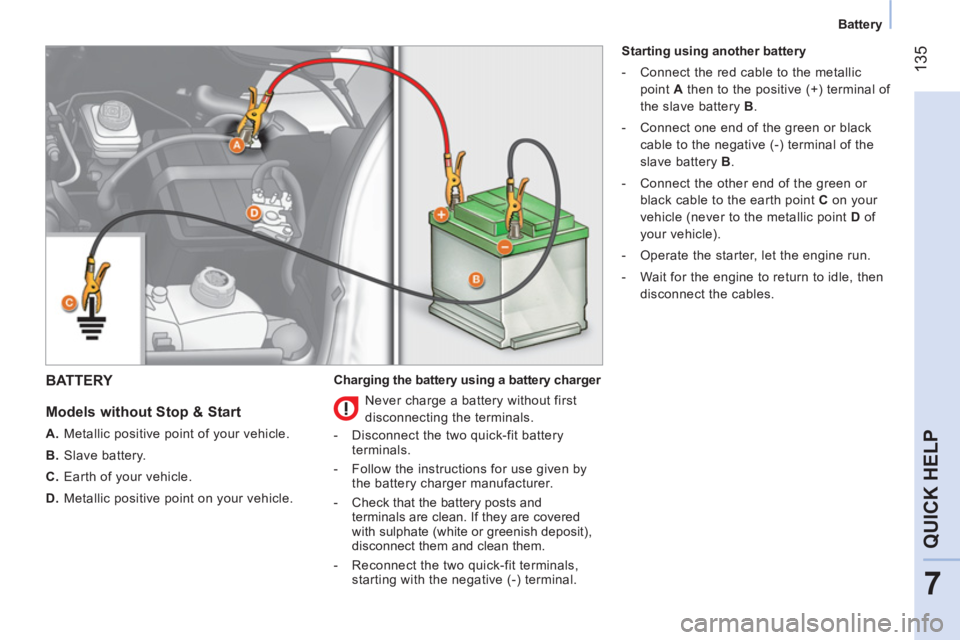
135
7
QUICK HELP
Battery
BATTERY
Models without Stop & Start
A.
Metallic positive point of your vehicle.
B.
Slave battery.
C.
Earth of your vehicle.
D.
Metallic positive point on your vehicle.
Charging the battery using a battery charger
Starting using another battery
- Connect the red cable to the metallic
point A
then to the positive (+) terminal of
the slave battery B
.
- Connect one end of the green or black
cable to the negative (-) terminal of the
slave battery B
.
- Connect the other end of the green or
black cable to the earth point C
on your
vehicle (never to the metallic point D
of
your vehicle).
- Operate the starter, let the engine run.
- Wait for the engine to return to idle, then
disconnect the cables.
Never charge a battery without first
disconnecting the terminals.
- Disconnect the two quick-fit battery
terminals.
- Follow the instructions for use given by
the battery charger manufacturer.
- Check that the battery posts and
terminals are clean. If they are covered
with sulphate (white or greenish deposit),
disconnect them and clean them.
- Reconnect the two quick-fit terminals,
starting with the negative (-) terminal.
Page 138 of 180
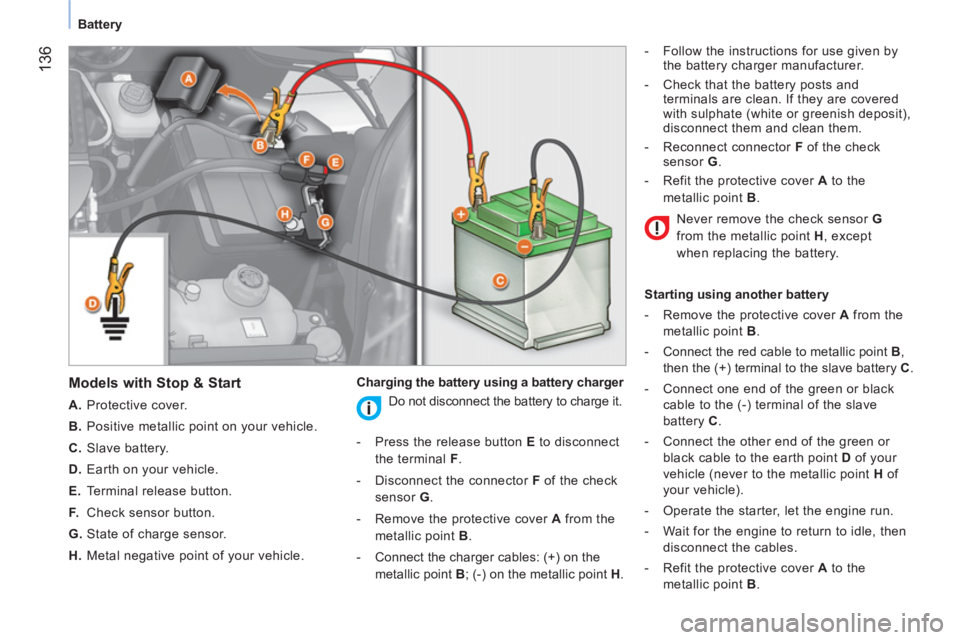
136
Battery
Models with Stop & Start
A.
Protective cover.
B.
Positive metallic point on your vehicle.
C.
Slave battery.
D.
Earth on your vehicle.
E.
Terminal release button.
F.
Check sensor button.
G.
State of charge sensor.
H.
Metal negative point of your vehicle.
Charging the battery using a battery charger
- Follow the instructions for use given by
the battery charger manufacturer.
- Check that the battery posts and
terminals are clean. If they are covered
with sulphate (white or greenish deposit),
disconnect them and clean them.
- Reconnect connector F
of the check
sensor G
.
- Refit the protective cover A
to the
metallic point B
.
Starting using another battery
- Remove the protective cover A
from the
metallic point B
.
- Connect the red cable to metallic point B
,
then the (+) terminal to the slave battery C
.
- Connect one end of the green or black
cable to the (-) terminal of the slave
battery C
.
- Connect the other end of the green or
black cable to the earth point D
of your
vehicle (never to the metallic point H
of
your vehicle).
- Operate the starter, let the engine run.
- Wait for the engine to return to idle, then
disconnect the cables.
- Refit the protective cover A
to the
metallic point B
.
Do not disconnect the battery to charge it.
- Press the release button E
to disconnect
the terminal F
.
- Disconnect the connector F
of the check
sensor G
.
- Remove the protective cover A
from the
metallic point B
.
- Connect the charger cables: (+) on the
metallic point B
; (-) on the metallic point H
. Never remove the check sensor G
from the metallic point H
, except
when replacing the battery.
Page 139 of 180
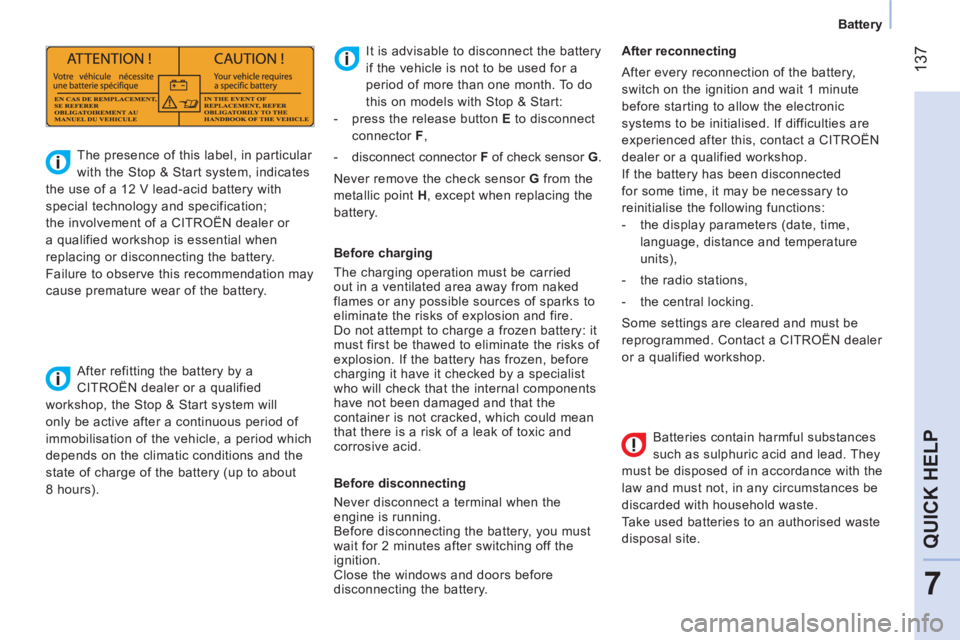
137
7
QUICK HELP
Battery
Batteries contain harmful substances
such as sulphuric acid and lead. They
must be disposed of in accordance with the
law and must not, in any circumstances be
discarded with household waste.
Take used batteries to an authorised waste
disposal site.
It is advisable to disconnect the battery
if the vehicle is not to be used for a
period of more than one month. To do
this on models with Stop & Start:
- press the release button E
to disconnect
connector F
,
- disconnect connector F
of check sensor G
.
Never remove the check sensor G
from the
metallic point H
, except when replacing the
battery.
The presence of this label, in particular
with the Stop & Start system, indicates
the use of a 12 V lead-acid battery with
special technology and specification;
the involvement of a CITROËN dealer or
a qualified workshop is essential when
replacing or disconnecting the battery.
Failure to observe this recommendation may
cause premature wear of the battery.
After refitting the battery by a
CITROËN dealer or a qualified
workshop, the Stop & Start system will
only be active after a continuous period of
immobilisation of the vehicle, a period which
depends on the climatic conditions and the
state of charge of the battery (up to about
8 hours).
Before charging
The charging operation must be carried
out in a ventilated area away from naked
flames or any possible sources of sparks to
eliminate the risks of explosion and fire.
Do not attempt to charge a frozen battery: it
must first be thawed to eliminate the risks of
explosion. If the battery has frozen, before
charging it have it checked by a specialist
who will check that the internal components
have not been damaged and that the
container is not cracked, which could mean
that there is a risk of a leak of toxic and
corrosive acid.
Before disconnecting
Never disconnect a terminal when the
engine is running.
Before disconnecting the battery, you must
wait for 2 minutes after switching off the
ignition.
Close the windows and doors before
disconnecting the battery.
After reconnecting
After every reconnection of the battery,
switch on the ignition and wait 1 minute
before starting to allow the electronic
systems to be initialised. If difficulties are
experienced after this, contact a CITROËN
dealer or a qualified workshop.
If the battery has been disconnected
for some time, it may be necessary to
reinitialise the following functions:
- the display parameters (date, time,
language, distance and temperature
units),
- the radio stations,
- the central locking.
Some settings are cleared and must be
reprogrammed. Contact a CITROËN dealer
or a qualified workshop.
Page 140 of 180

138
Changing a wheel
CHANGING A WHEEL
Parking the vehicle
As far as possible, park the vehicle on level,
stable and non-slippery ground.
Apply the parking brake, switch off the
ignition and engage first gear (on a hill).
It is imperative that you ensure that the
occupants get out of the vehicle and wait in
a safe location.
If possible, place a chock under the
wheel diagonally opposite the wheel to be
changed.
Tools
The tools required are stored in a tool kit
located behind the driver's seat (Light van)
or behind the rear bench seat (Combi).
1.
Wheelbrace.
2.
Centring guide.
3.
Screwdriver.
4.
Jack with handle.
5.
Removable towing eye.
The jack and all of the tools are specific
to your vehicle. Do not use them for other
purposes.
Never go underneath the vehicle when it is
raised only by the jack; use an axle stand.
Taking out the spare wheel
The spare wheel retaining bolt is located on
the rear left part of the loading sill.
1.
Slacken the wheel retaining bolt using the
wheelbrace.
2.
Unscrew fully to unwind the winch cable.
3.
Take out the spare wheel using the
wheelbrace.
4.
Raise the cover A
.
5.
Remove the cable B
from its housing.
6.
Release the spare wheel and place it
near the wheel to be changed.